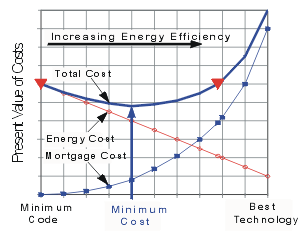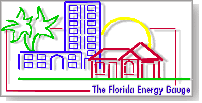|
Do you really want the worst
home
allowed by law?
Here are 6 facts to
consider:
- Fact #1: The standards of
the Florida Energy Efficiency Code for Building
Construction represent the worst buildings allowed
by law to be built in Florida.
- Fact #2: The majority of
Florida homes are built to the State's bare minimum
energy-efficiency standards. A 1995 field research study
conducted by FSEC and published as a Report to the Florida
Public Service Commission by Florida Power and Light Company
showed the average efficiency of new Florida homes to be right
at Florida's minimum Code requirement. This same study also
showed that Code compliance is not uniformly enforced, with
many of the 423 field-study homes failing to conform to the
standards submitted by the builder to the Code official for
permitting purposes.(1)
- Fact #3: The Florida
Energy Code has not changed substantively since 1985.
The result is that homes built today can draw from 14 years of
technology improvements and must be significantly more
efficient than Florida Energy Code requirements if their cost
effectiveness is to be optimized. (Want to see how much a
typical Florida home can be improved -- click
here.)
- Fact #4: The price
of a home considers only what you must pay to purchase the
home (the mortgage costs). Home owners, however, must
consider the total cost of ownership, which
includes both the "price" as well as what must be
paid to live in the home (the operating costs). Most
people don't realize it but, on average, a typical Florida
home owner will pay more than $50,000 to provide the energy
for a small, code-complaint Florida home over the course of
the mortgage.
- Fact #5: The only
reasonable means of accurately determining the relative energy
efficiency and the total costs for a home is through an Energy
Rating using the Florida Energy Gauge Program -- remember,
Florida's Energy Code is a pass/fail minimum standard.
- Fact #6: Quality is not
free but a small investment in a Home Energy Rating can save
you thousands of dollars in costs for your home.
Note also that only those persons who are certified by the
State are authorized to conduct energy ratings in Florida
Most homes, new or existing,
can be substantially improved and return money to their owner from
day one!
The chart below illustrates how these savings occur, even in
proposed new, "code-compliant" homes.
 As you improve
the efficiency of a new home, the present value of its
"price" (mortgage cost) increases - more and more
rapidly as you approach the best available technology.
Simultaneously, however, the operating cost (energy cost)
decreases. There is a point, which is much more energy
efficient than Minimum Code, at which the sum of the mortgage and
energy cost (total cost) is minimized. This point is
labeled on the horizontal axis of chart as Minimum
Cost with an arrow
pointing to the lowest point on the total cost curve. It is worth
noting that the cost of owning the minimum code home is greater
than the cost of owning a more energy efficient home until the
point indicated by the large triangle on the right side of the
total cost curve is reached. Thus, substantial improvements in
efficiency (and quality and comfort) are typically very
cost-effective. As you improve
the efficiency of a new home, the present value of its
"price" (mortgage cost) increases - more and more
rapidly as you approach the best available technology.
Simultaneously, however, the operating cost (energy cost)
decreases. There is a point, which is much more energy
efficient than Minimum Code, at which the sum of the mortgage and
energy cost (total cost) is minimized. This point is
labeled on the horizontal axis of chart as Minimum
Cost with an arrow
pointing to the lowest point on the total cost curve. It is worth
noting that the cost of owning the minimum code home is greater
than the cost of owning a more energy efficient home until the
point indicated by the large triangle on the right side of the
total cost curve is reached. Thus, substantial improvements in
efficiency (and quality and comfort) are typically very
cost-effective.
This example illustrates the operating principal of ENERGYGAUGE
Pro's optimization
feature, whereby the present values of the mortgage costs are
balanced against the present value of the energy savings and only
the most cost-effective improvements are incorporated into the
home. Now, for the first time in Florida, there is a uniform,
"expert system" in place that can measure and report on
the economic and financial impacts of home energy technology
decisions. Certified Florida Raters
are equipped with these energy analysis and evaluation tools, and
for an investment of only a few hundred dollars, you can save
thousands of dollars on your home purchase, new or existing.
And you can take it to the
bank!
There are increasing numbers of mortgage bankers
offereing Energy Efficient Mortgages (EEMs)
and utility and government programs
that are "honoring" the energy savings projected by
certified home energy rating systems. Tools like ENERGYGAUGE
in the hands of Certified Raters now make this a feasible
alternative for Florida home owners and buyers. And to ensure
mortgage industry accreditation, misrepresentation of the ENERGYGAUGE
results has been made purposely difficult through a policy of full
disclosure. Each of the user-selected economic and financial
assumptions and each improvement along with its cost, its cost
basis (source), its lifetime and any other associated costs or
benefits are clearly printed on the output reports. This is done
to ensure that financial results are properly interpreted and, if
necessary, can be fully replicated.
In summary, Florida's Building Energy Efficiency Rating System
represents a significant economic opportunity from which everyone
can benefit. The economic and market value of energy Ratings to
each of the impacted parties can be summarized as follows:
- Home buyers can literally get
more home for less money by taking advantage of the operating
cost savings of improved energy efficiency. They also will get
a higher-quality, more comfortable home.
- Home owners can increase their
equity and cash flow positions and achieve a greater market
value for their property at the time of sale.
- Home builders can achieve
greater profitability through the sale of higher quality
buildings, reductions in "call backs" and improved
customer satisfaction.
- Realtors can close more sales,
more quickly by using the expanded market and qualifying power
of Energy Efficient Mortgage underwriting and financial
institution incentive programs.
- Lenders can increase their
share of the mortgage market and simultaneously lower their
default risk as a result of the improved cash flow position of
borrowers.
- Florida (and the Nation) can
achieve positive economic impacts through increased jobs and
attain greater economic and environmental sustainability
through reductions in energy use and air pollution.
1. Florida Power
and Light Company, New Home Construction Research Project
Findings, Results & Recommendations, Final Report, Exhibit
25, Report to the Florida Public Service Commission, Tallahassee,
FL, June 1, 1995. |


 As you improve
the efficiency of a new home, the present value of its
"price" (mortgage cost) increases - more and more
rapidly as you approach the best available technology.
Simultaneously, however, the operating cost (energy cost)
decreases. There is a point, which is much more energy
efficient than Minimum Code, at which the sum of the mortgage and
energy cost (total cost) is minimized. This point is
labeled on the horizontal axis of chart as Minimum
Cost with an arrow
pointing to the lowest point on the total cost curve. It is worth
noting that the cost of owning the minimum code home is greater
than the cost of owning a more energy efficient home until the
point indicated by the large triangle on the right side of the
total cost curve is reached. Thus, substantial improvements in
efficiency (and quality and comfort) are typically very
cost-effective.
As you improve
the efficiency of a new home, the present value of its
"price" (mortgage cost) increases - more and more
rapidly as you approach the best available technology.
Simultaneously, however, the operating cost (energy cost)
decreases. There is a point, which is much more energy
efficient than Minimum Code, at which the sum of the mortgage and
energy cost (total cost) is minimized. This point is
labeled on the horizontal axis of chart as Minimum
Cost with an arrow
pointing to the lowest point on the total cost curve. It is worth
noting that the cost of owning the minimum code home is greater
than the cost of owning a more energy efficient home until the
point indicated by the large triangle on the right side of the
total cost curve is reached. Thus, substantial improvements in
efficiency (and quality and comfort) are typically very
cost-effective.